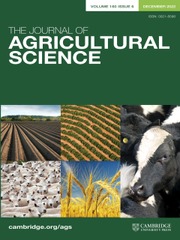No CrossRef data available.
Article contents
Effect of P and Zn addition on maize grown on calcareous soils
Published online by Cambridge University Press: 27 March 2009
Extract
Nutritional problems for cultivated plants related to phosphorus (P) and zinc (Zn), among other elements, are common in recent alluvial calcareous soils of Greece. The negative interaction which exists between these two elements aggravates these problems.
- Type
- Short Note
- Information
- Copyright
- Copyright © Cambridge University Press 1983
References
Chapman, H. D. & Pratt, P. F. (1961). Methods of Analysis for Soils, Plants and Water. University of California.Google Scholar
Jackson, M. L. (1958). Soil Chemical Analysis. Englewood Cliffs, N. J.: Prentice Hall Inc.Google Scholar
Koukoulakis, P. (1967). Zinc, phosphorus, nitrogen interrelationships in maize nutrition. M.Sc. thesis, American University of Beirut.Google Scholar
Langin, E. J., Ward, R. C. & Olson, R. A. (1962). Factors responsible for poor response of corn and grain sorghum to phosphorus fertilization. II. Lime and P placement effects on P–Zn relations. Proceedings. Soil Science Society of America 26, 274–278.CrossRefGoogle Scholar
Papanicolaou, E. P. (1976). Determination of cation exchange capacity of calcareous soils and their percent base saturation. Soil Science 121, 65–71.CrossRefGoogle Scholar
Papanicolaou, E. P., Skarlou, V. D. & Apostolakis, C. G. (1977). A study of placement methods of phosphate fertilizer labelled with 32P in cultivation of beans. Agrochimica 21, 451–460.Google Scholar
Papanicolaou, E. P., Skarlou, V. D., Nobeli, C. & Katranis, N. S. (1982). Fertilizer sources and placement methods in corn using labelled fertilizers. Twelfth International Society of Soil Science Congress, New Delhi, India, 02 8–16, 1982.Google Scholar


